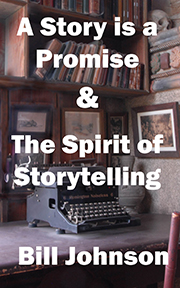| A Story is a Promise |
|
|
| Essays on the Craft of Writing |
|
|
| About the Author |
How to Write a Movie Script

One of the most common problems for someone writing a first script is what I call 'watch the movie, write down the details.' By this I mean mentally watching the scenes of a film script and writing down the details of what you see. This leads to a first script that is a collection of details, what characters are doing. 'Mary, blonde and athletic, walked across the room. John, stocky, male, 45, picked up the book.' These kind of flat, descriptive details are tedious to read and fail to convey the dramatic purpose of a scene.
Students will be helped in this class to replace that kind of language with a visual language appropriate for a movie script.
Another place that students become blocked is coming up with a sequence of scenes. In this class, I teach a 3/5 card system for organizing ideas. Each student is asked to carry some 3/5 cards around, and each time they have an idea for a scene, or dialogue, or some understanding of a character, they write it on a card, one idea to a card. This frees student from needing to understand what comes next, with just a focus on coming up with ideas. It can be very liberating. I suggest students do this until they have 40-50 cards, then start looking at how those cards can be put into some kind of order as scenes.
One of the five sessions of the class will be spent breaking down a movie like Sleepless in Seattle, which has a very transparent story structure. Many new writers to screenwriting are what I call blind imitators. They think they are doing what successful screenwriters are doing, but in reality they aren't. Conveying that Tom Hanks character in Seattle is overwhelmed by grief is different than writing that his character has brown hair and an average build.
Whether or to obtain copyright for a script is another issue students wrestle with. Technically, anything someone writes, they hold the copyright. Emailing or mailing a manuscript to the Copyright office. if you are just writing a first script and have little expectation that anything will happen with it, you don't absolulely need to pay for copyright. To me, it's just part of the cost of doing business.
If a student wants to show a script to anyone in Hollywood, they do need to register their script with the WGAw (Writers Guild of America West) or WGAe, for Writers Guild of America East. Studios will not read a script that has not been registered with the WGA or submitted by a WGA certified agent.
If, by some stroke of great good fortune a studio agreed to read a student script, the other option is to have an entertainment attorney submit the script.
The goal of this class, however, is that students be able to leave the class with an ability to break down and understand the movies they are watching outside of class, as a technique to teach themselves how to write a movie script.
Final Draft is a program I recommend to students. It's a full-featured program used by production companies and producers in Hollywood.
CeltX is a free program that can be used to format a movie script. Using a formatting program saves a tremendhous amount of time.
Top of page
